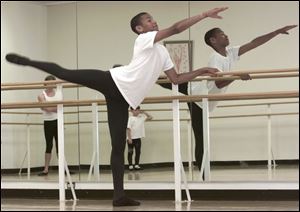
The boys of ballet
7/20/2003
Alexander Catchings, 15, demonstrates an action pose in the Toledo Ballet studio.
Six months ago, Beverly Elementary School student Tyler Bell, 12, didn't know Swan Lake from Snow White. Today, he throws around terms like pirouette and pique with the casual air of a learned aesthete.
Alexander Catchings, 15, can dunk a basketball, but that kind of leaping is no big deal, he says. He has moved on to bigger challenges.
Tyler and Alexander are among the boys to men, ages 7 to 50, who dance with the Toledo Ballet.
“African dance rules; modern is even better. But the truth is, all that comes super easy when you know ballet. That's where the challenge is. With the leaps and all, ballet classes can be suicidal. That's just the way it is,” says Alexander.
During the school year, Alexander dances up to eight hours a day, five and six days a week. To relax, and give his body “a break,” he takes 15-mile excursions on his roller blades or plays tennis.
When Nigel Burgoine took over as the company's artistic director six years ago, there was just one boy enrolled in classes. This spring there were 29, along with 314 girls.
“We used to have to practice partnering with our dads, now we have options,” says 17-year-old ballet company member Lauren Deimling Johns of Perrysburg.
There is a trend towards dance, says Burgoine.
“Young people understand that if they want to move into theater, they have to have a strong idea about body movement. That's the new reality. Look around, everything from Matrix Reloaded to community theater is highly choreographed. Even Arnold Schwarzenegger studied ballet,” says Burgoine.
“Dance offers all kinds of challenges.
Being able to control a 120-pound ballerina balancing on a toe point the size of a dime is incredibly difficult,” he adds.
Physical prowess is just part of it.
For boys, just walking through the door is intimidating and stimulating. Ballet studios, notes Lauren, are full of “lots of cute, flexible girls in tights who want you to hold them and throw them around.”
Growing up, Matthew Oster was the company's only boy. Now in college, he concedes that being “the only guy in classes with 20 girls wearing next to nothing” made a significant impression.
His peers rarely saw the potential, however.
“I was teased a lot outside of class. People said ballet was a girl's thing, but I had decided I wanted to do it and nothing was going to stop me,” says Matthew.
That was fine with the girls.
“The boys have a home at Toledo Ballet. It's really great to see that they are brave enough to pursue their goals,” says 17-year-old Natalie Cubbon, a student at St. Ursula Academy.
In scenarios reminiscent of Billy Elliot, every boy interviewed for this story mentioned peer pressure of one sort or another. Every boy also said he was going to do what he wanted no matter what other kids might say.
“Guys have told me I must be gay if I wear tights. I tell them they can't do half the things I can do,” says Alexander.
Even Spencer Hack, who turns 7 this month and attends the West Side Montessori School, has felt peer pressure.
“Kids have made fun of my ballet, but who cares? If girls can do it, boys can too,” he says.
Spencer made his company debut last December in The Nutcracker and has learned that determination breeds experience and experience breeds determination.
The older these children get, the more skills they bring to the table.
Brian Slayman, who just graduated from Toledo School for the Arts, came to ballet from a background in gymnastics. A mainstay in recent Toledo Ballet productions, Brian does back flips as easily as most of us touch our toes.
Later this month he heads to Japan to fulfill a nine-month contract dancing for Disney.
Mark Woten is another Toledo Ballet soloist. The 25-year-old Bowling Green State University graduate and Lima native has a background in the Brazilian martial art called capoeira, and studies karate. He has investigated Japanese buto and other world movement traditions.
Burgoine loves the options such diversity brings to his company. The school's offerings reflect that interest.
Over the last four years Ghanaian dancer Habib Iddrisu has joined Burgoine in giving hundreds of African dance presentations in Toledo area schools. Woten teaches hip-hop dance in the ballet studios.
Hip-hop at Toledo Ballet?
Burgoine says the combination is terrific.
“Ballet offers skills useful to any kind of dance. Diversity makes us even stronger,” he says.
Diversity also opens doors for students.
Hip-hop is my passion,” says Woten. “I like to turn up the volume and allow the music to be the dictator. Then your body follows and does what it has to do. But the reality is that with ballet training, my body is able to do more. Even though the styles are so different, I've got a much richer vocabulary.
“Hip-hop is low to the ground and African; ballet is upright and European. Hip-hop is funky, pirouettes aren't. Even so, the styles can go together. Ballet has given me lots of new movements to work with.”
That kind of creativity has made Woten “the jewel in Toledo Ballet's crown,” says Burgoine.
For Woten, dance has offered a path to new worlds.
“Boys should be given the opportunities to explore what they are talented in. We need to respect each other and take care of each other. If you like to dance, dance your heart out,” he says.